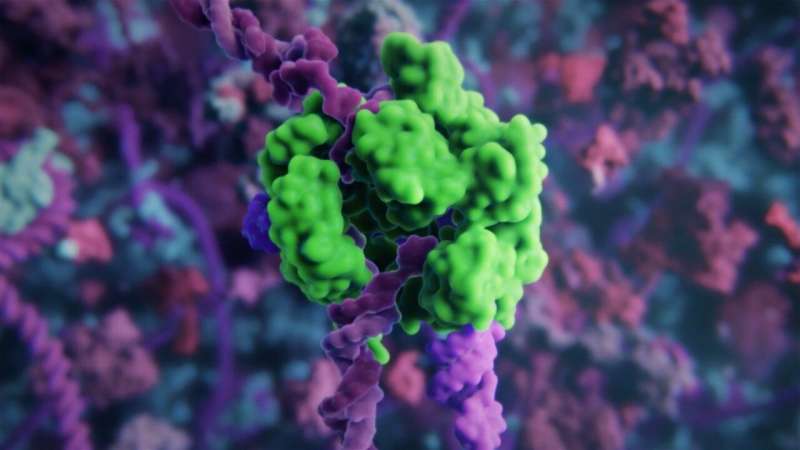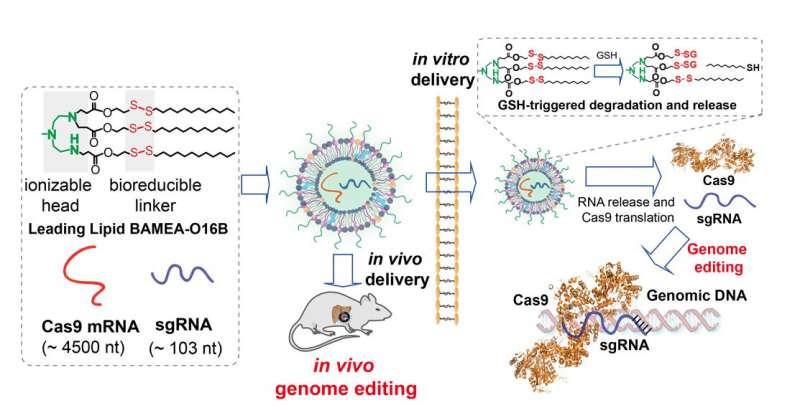Novel nanoparticles deliver CRISPR gene editing tools into the cell with much higher efficiency

A research collaboration between Tufts University and the Chinese Academy of Sciences has led to the development of a significantly improved delivery mechanism for the CRISPR/Cas9 gene editing method in the liver, according to a study published recently in the journal Advanced Materials. The delivery uses biodegradable synthetic lipid nanoparticles that carry the molecular editing tools into the cell to precisely alter the cells' genetic code with as much as 90 percent efficiency. The nanoparticles represent one of the most efficient CRISPR/Cas9 delivery tools reported so far, according to the researchers, and could help overcome technical hurdles to enable gene editing in a broad range of clinical therapeutic applications.
The CRISPR/Cas9 gene editing system has become a powerful research tool uncovering the function of hundreds of genes and is currently being explored as a therapeutic tool for the treatment of various diseases. However, some technical hurdles remain before it can be practical for clinical applications. CRISPR/Cas9 is a large molecular complex, containing both a nuclease (Cas9) that can cut through both strands of a targeted genomic sequence, and an engineered 'single-guide' RNA (sgRNA) that scans the genome to help the nuclease find that specific sequence to be edited. Since it is a large molecular complex, it is difficult to deliver CRISPR/Cas9 directly into the nucleus of the cell, where it can do its work. Others have packed the editing molecules into viruses, polymers, and different types of nanoparticles to get them into the nucleus, but the low efficiency of tranfer has limited their use and potency for clinical applications.
The lipid nanoparticles described in the study encapsulate messenger RNA (mRNA) encoding Cas9. Once the contents of the nanoparticles—including the sgRNA—are released into the cell. The cell's protein-making machinery takes over and creates Cas9 from the mRNA template, completing the gene editing kit. A unique feature of the nanoparticles is made of synthetic lipids comprising disulfide bonds in the fatty chain. When the particles enter the cell, the environment within the cell breaks open the disulfide bond to disassemble the nanoparticles and the contents are quickly and efficiently released into the cell.

"We are just starting to see human clinical trials for CRISPR therapies," said Qiaobing Xu, co-corresponding author of the study and associate professor of biomedical engineering at Tufts University. "There are many diseases that have long been intractable for which CRISPR therapies could offer new hope—for example sickle cell disease, Duchenne muscular dystrophy, Huntington's disease, and even many cancers. Our hope is that this advance will take us another step toward making CRISPR an effective and practical approach to treatment."
The researchers applied the new method to mice, seeking to reduce the presence of a gene coding for PCSK9, the loss of which is associated with lower LDL cholesterol, and reduced risk of cardiovascular disease. "The lipid nanoparticles are one of the most efficient CRISPR/Cas9 carriers we have seen," said Ming Wang, also co-corresponding author of the study and professor at the Chinese Academy of Sciences, Beijing National Laboratory for Molecular Science. "We can actually knock down PCSK9 expression in mice with 80 percent efficiency in the liver, suggesting a real promise for therapeutic applications."
More information: Ji Liu et al, Fast and Efficient CRISPR/Cas9 Genome Editing In Vivo Enabled by Bioreducible Lipid and Messenger RNA Nanoparticles, Advanced Materials (2019). DOI: 10.1002/adma.201902575
Journal information: Advanced Materials
Provided by Tufts University





















